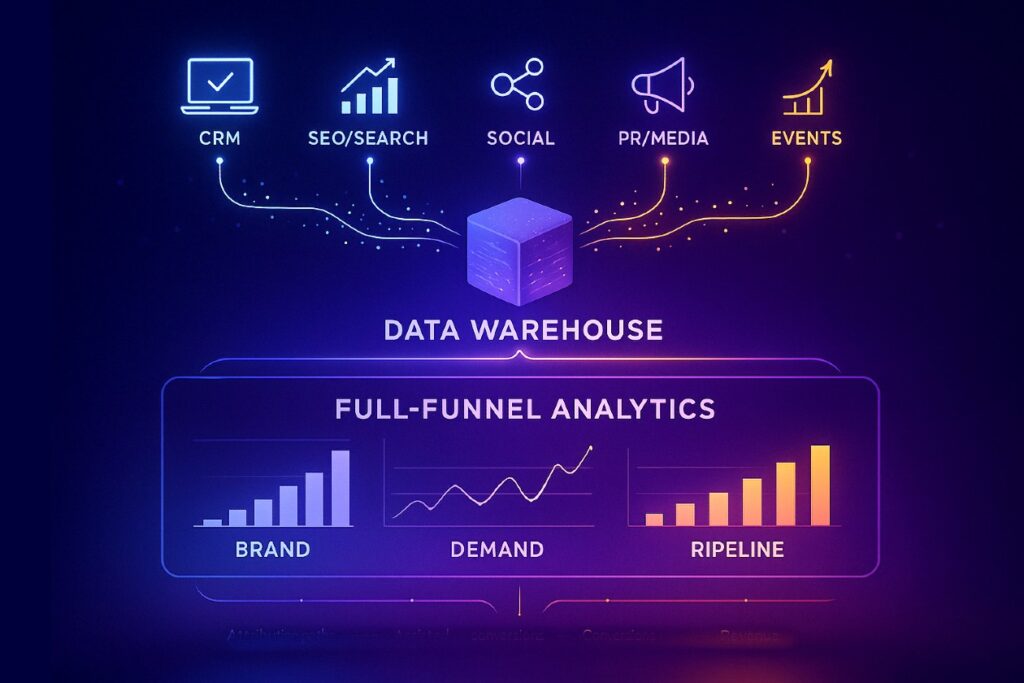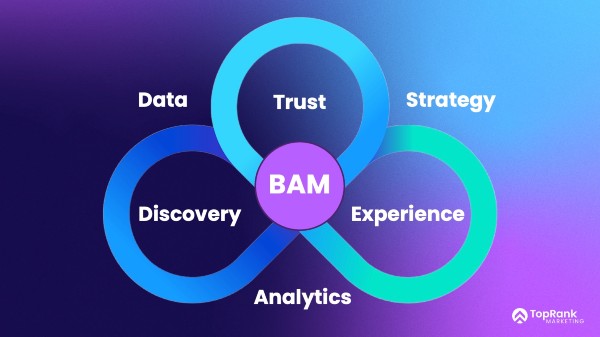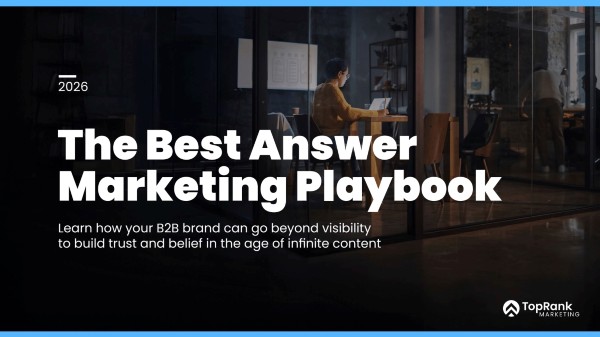B2B marketing strategies that actually work are centered around creating useful content experiences that build trust and influence business outcomes. At the same time, great B2B marketing is also about proving what works, finding the gaps, and making adjustments to improve performance. That’s the promise of full funnel, Unified Analytics in the Best Answer Marketing (BAM) system: to unify multi-channel data into a single view so you can optimize brand, demand, and revenue outcomes with confidence.
Why B2B marketing measurement is harder than ever
Measurement is a top CMO pain point. The 2025 CMO Survey (pdf) reports “demonstrating the impact of marketing actions on financial outcomes” is still the #1 challenge, cited by 64% of marketing leaders, and felt even more so amongst B2B brands.
B2B buyers use many more channels. We’ve mentioned this before because the behavior is foundational for why being the best answer across channels is critical. McKinsey’s B2B Pulse shows that buyers now use 10+ interaction channels along the journey, making attribution and signal-tracking inherently multi-touch.
Content measurement struggles are persistent. CMI’s recent B2B research highlights the same persistent measurement hurdles: attributing ROI to content and tracking customer journeys (each 56%), plus integrating data across platforms continues to challenge marketers.
Now add AI-powered search, where visibility often comes via citations and summarizations instead of clicks, and you’ve got a world where measuring influence across channels, formats, and surfaces is essential if you’re going to get a clear picture of what’s working and what’s not. The simple days of last-click conversions are over.
What Full-Funnel Analytics means inside the BAM system
Full-Funnel Analytics powers every pillar of BAM by turning disparate signals into a source of truth. This approach also closes the loop with the Data-Informed pillar: many of the kinds of data that shape initial strategy and goal-setting are connected to the types of data that full-funnel measurement later validates and optimizes against. This ensures BAM is a continuous cycle of insight → strategy → execution → measurement → refinement across the pillars:
- BAM Pillar 1: Data-Informed → Identify the questions, topics, stories, channels, and formats that move buyers.
- BAM Pillar 2: Integrated Strategy → A plan that aligns answer-topic narratives to measurable funnel outcomes (brand → demand → revenue).
- BAM Pillar 3: Trust System → Quantify the lift from influencer mentions, earned media, analyst citations, customer advocacy, thought leadership and original research.
- BAM Pillar 4: Experiential Content → See which experiences (video, interactive, events) advance prospects from tire kicking interest to active engagement and consideration.
- BAM Pillar 5: Multi-Channel Discovery → Track where content is discovered and consumed: search, AI overviews, newsletters, PR, social, ads, etc and reinvest accordingly.
The BAM data foundation: unify first, then optimize
For the BAM Unified Analytics pillar, centralizing data is the unlock. A modern marketing and sales intelligence platform pulls in paid, social, web, CRM, event, and earned media data; normalizes it; and makes it analytics-ready for BI and modeling. With this kind of data warehouse, you can eliminate swivel-chair reporting and enable more consistent multi-touch views across channels and formats.
How the BAM analytics stack comes together
- Step 1: Connect your data (Pipelines & unification): Here, we bring in data from up to 500+ potential sources like CRM, web analytics, and ad platforms into one warehouse. For example, you could connect Google Search Console data on brand + topic impressions with social listening data to reveal a variety of signals like showing movement in conversations on your answer topics across search and social media.
- Step 2: Organize and model it (Warehouse & models): In this step we store and clean the data so it’s ready for trend, cohort, and multi-touch attribution analysis. For example, you might model correlations between those search impressions, the social conversation lift, and intent signals such as GPT-sourced inquiries mentioning your services.
- Step 3: Turn it into insights (BI & activation): Now we build dashboards that show performance across brand → demand → revenue and feed that back into marketing channels. For example, you could visualize how increases in AI and search visibility, combined with social buzz, connect to actual pipeline creation which can provide the necessary confidence to adjust marketing investments accordingly.
What to track and why with BAM full funnel marketing
When implementing a BAM full-funnel marketing strategy, there’s an emphasis on tracking metrics that align to brand, demand, and revenue outcomes.
On the brand side, this means things like measuring share of voice across search and AI answers, analyst and media citations, influencer reach and engagement, branded search lift, follower growth, and event reach. Trust and distinctiveness at this stage matter because they correlate with later-stage efficiency. Remember, what we said earlier about McKinsey’s research and omnichannel winners sustaining growth by being present and credible across touchpoints.
For demand generation, the focus shifts to consideration and intent. This is where we should look at topic-level content engagement, repeat exposures, assisted conversions, content path depth, demo-to-MQL rates (when appropriate), and the influence of experiential assets like webinars, videos, podcasts and tools. These metrics are especially important given that ROI attribution and journey tracking remain persistent challenges as mentioned by the research from CMI.
Finally, at the revenue stage, we can look at multi-touch contribution to Sales Qualified Opportunities (SQOs) and revenue as well as things like opportunity velocity by content track, the influence of trust assets on late-stage win rates, and account-level lift for ABM programs. Metrics like these matter because expectations for accountability are higher than ever and being able to provide a clear link between spend and financial outcomes is as essential for marketing performance as it is marketing career continuity.
How attribution fits in the BAM system
Attribution in a BAM program provides insights of course, but also creates a structured learning loop, Here’s how:
- Data-Informed → Integrated Strategy: We start by collecting clean attribution data across CRM, analytics, and campaigns to reveal which questions, topics, and channels appear in real buyer journeys. Then map those touchpoints to funnel stages and align narratives to business goals.
- Trust System → Experiential Content: Here we identify where credibility signals (influencer posts, PR coverage, testimonials) and experiences (webinars, videos, calculators) advance buyers. Then make improvements to creating moments of trust and content formats that measurably move prospects from passive interest to active evaluation.
- Multi-Channel Discovery → Full-Funnel Analytics: Now we can see where content is discovered (Google, AI overviews, social media newsletters, media, search and social ads, etc), and then feed those insights into a data warehouse model to understand trends and performance. In tern, those data-informed performance insights will inform where to adjust budget to the discovery paths that consistently influence pipeline and revenue.
Forrester’s 2025 look at B2B measurement reinforces this shift from individual KPIs and metrics to system-level insight that closes the loop between investment and business impact. While only 28% of B2B marketing leaders are confident in their ability to measure marketing’s impact on revenue, companies adopting system-level analytics are 2.3x more likely to report significant revenue growth compared to peers still using isolated metrics. The BAM Unified Analytics approach works to create a unified view of marketing performance to give B2B brands a system-level view of what’s working and where to improve. This is a distinct advantage over how most B2B companies are managing their marketing analytics.
How can B2B brands tell if they’re the best answer for customers?
Buyers ask questions at every stage of their journey, and brands need a clear way to see whether their content and experiences are doing the job. A BAM Full-Funnel Analytics system is designed to help answer these fundamental questions in a connected way.
First, are we being found by the right buyers? This starts with visibility. Are your solutions showing up where it matters-from search and AI overviews to organic rankings, media mentions, influencer content, and advertising impressions that turn into clicks and engagement?
Next, are those experiences creating progress? Once buyers find you, the question is whether they’re moving forward. For example, are they going from attending a webinar to using an interactive tool and then requesting a demo? This shows whether multiple touches are working together to move people from awareness to opportunity.
Then, are trust signals changing outcomes? Beyond engagement, are credibility markers making a measurable difference? Deals may be influenced by influencer mentions, PR, or analyst coverage. Win rates may improve when research or testimonials are included. Appearances in AI summaries or chatbot answers can also drive referred traffic with clear commercial intent.
Finally, where should we invest next? With all this insight, brands can adjust resources more effectively. Which channels or topics are delivering the best return? Which underused areas are worth more attention? And what experiments could unlock measurable growth?
Together, these questions build on one another to provide a full picture of whether your brand is being discovered, trusted, and chosen-and how to keep improving toward being the best answer.

Bringing it to life with the right data intelligence solution
A marketing and sales intelligence platform approach should automate ingestion, normalization, and monitoring across paid, social, search, web, CRM, events, and earned sources which creates an analysis-ready data layer that marketing can trust. This kind of solution that we employ at TopRank Marketing in partnership with Improvado, enables faster diagnostics (what’s working), cleaner experimentation (what to test), and clearer storytelling to the C-suite about how BAM drives revenue.
The Best Answer Marketing system comes together and what’s next

Unified, Full-Funnel Analytics is the connective tissue of the BAM system. It turns Data-Informed inputs into Integrated Strategy decisions; quantifies how the Trust System and Experiential Content change buyer behavior; and proves which Multi-Channel Discovery paths actually drive pipeline and revenue. With a data warehouse powered analytics layer, you can move beyond reporting towards intelligent optimization that powers which adjustments to make on the answer topics, narratives, formats, and channels that make your brand the best answer wherever buyers look.
So far we’ve covered all 6 pillars of the Best Answer Marketing Framework including:
Pillar 1, Data Informed
Pillar 2, Integrated Strategy
Pillar 3, Trust System
Pillar 4, Experiential Content
Pillar 5, Multi-Channel Discovery
Pillar 6, Unified Analytics
Next up: our final post in the Best Answer Marketing Playbook series, the BAM Action Plan, which will give you a practical sequencing guide to deploy all six pillars together to help set your B2B brand up for success.

To get a PDF copy of the Best Answer Marketing Playbook, sign up below and we’ll send you a copy including best practices, research data, case studies, and a strategy checklist. PLUS access to our State of B2B Thought Leadership in 2026 Report.



